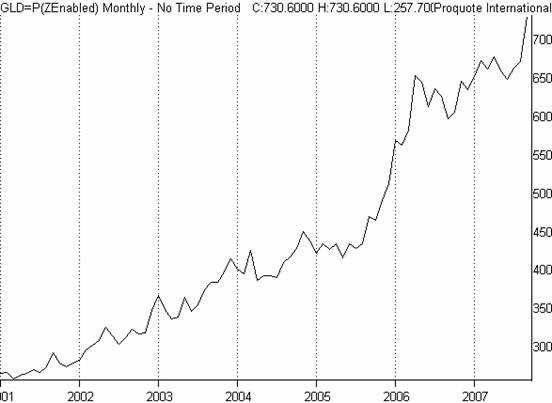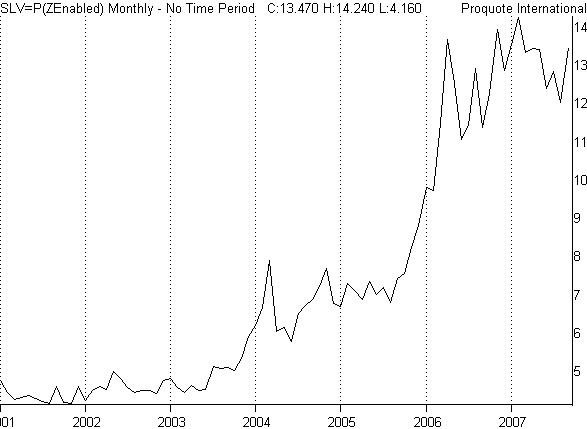Should You Own Precious Metals in a Retirement / Pensions Account?
Commodities / Pensions & Retirement Sep 27, 2007 - 12:03 PM GMTBy: Mike_Clark
 In recent years, a growing number of countries have permitted their citizens to establish personal retirement accounts and allow them to choose the investments they may hold, including precious metals. But should an investor include a precious metals component in his or her long-term investment plan? And if so, how does one decide which precious metal investment product to own for retirement purposes?
In recent years, a growing number of countries have permitted their citizens to establish personal retirement accounts and allow them to choose the investments they may hold, including precious metals. But should an investor include a precious metals component in his or her long-term investment plan? And if so, how does one decide which precious metal investment product to own for retirement purposes?
Introduction
In the mid 1970s, the United States Congress enacted the Employee Retirement Income Security Act (ERISA), which among other things, created the Individual Retirement Account (IRA) for American workers. The purpose of the IRA was to enable individual Americans to save for retirement on their own in special tax-deferred, personal investment accounts available through commercial financial institutions, and allow workers who changed jobs to preserve their employer-sponsored retirement plan assets by permitting them to transfer (or “roll-over”) their plan balances into IRAs.
Over the past several decades, the IRA and other so-called “self-directed” personal retirement plans, such as the 401k, have grown immensely popular among American workers, as they've been modified to include greater flexibility and expanded investment choices. In 1986, for example, the U.S. Tax Code was amended to allow IRAs to hold American Eagle Gold and Silver bullion coins, in addition to equities, fixed income, real estate investment trusts (REITS) and money market investments. These options were broadened further in 1997, when Congress also authorized the inclusion of investment grade gold, silver, platinum, and palladium bullion bars and coins in IRAs. More recently, other countries have followed suit. For example, Canada created the Registered Retirement Savings Plan (RRSP) several years back, and England recently established the Self-Invested Personal Pension (SIPP) as personal retirement savings vehicles for their respective investing citizens. Each of these plans permits precious metals investments, as well.
Precious Metals As Retirement Assets
There are many advantages to including a precious metals component within one's retirement investment portfolio. For example, because precious metals are negatively correlated to “traditional” investments like stocks and bonds -- that is, their market prices tend to move opposite those of stocks and bonds --, studies have shown that portfolios having modest amounts of precious metals exposure will experience less overall volatility and greater long term returns than will those same portfolios without the precious metals included. Also, owning precious metal investments can further diversify one's retirement holdings by adding a tangible asset that, unlike stocks and bonds, has inherent (i.e., innate ) value.
And another important consideration, particularly in light of the seven-year precious metals bull market we are currently experiencing – the gold price has increased on average more than 15% annually over the past seven years -- is the fact that while one may pay income taxes on withdrawals from the account once retired, the market gains made on precious metals investments held in a retirement plan are exempt from capital gains taxes. The value of this provision is further highlighted when one considers the fact that in America, gains of precious metals, including ETF's, held outside of an IRA are taxed at the 28% “collectable” rate, as compared to the normal capital gains rate of 15%. This feature can result in enormous savings and add considerable value to one's retirement investments over the life of the plan, especially under current market conditions. Note the strong price performance of gold, silver and platinum since 2001 in the charts that appear below.


Some Basics…
Once an investor decides to include a precious metals component within his or her individual retirement account, a decision as to how to make that investment – that is, which metal invest in and what vehicle to buy -- must be made. And to be sure, the choices are many. But before considering the alternatives in detail, let's review some basic guidelines concerning precious metals investing for IRAs…
In the U.S. , an IRA investor may currently invest $4,000 of his or her pre-tax income if under the age of 50, and $5,000 if age 50 or over, each year. Moreover, balances from corporately sponsored 401k or other retirement plans can be transferred into a personal IRA under certain circumstances, and as a result, the IRA may contain considerable asset value.
As with all investment portfolios, it is generally prudent for the investor to diversify the holdings in his/her retirement account. Accordingly, the retirement investor may include a precious metals component by acquiring precious metals mining stocks or mutual funds, Exchange Traded Funds (ETFs), investment grade gold, silver, platinum or palladium bullion bars and coins, or other instruments, such as the Perth Mint Precious Metals Certificate.
As with all IRA investments, precious metals investments of any kind must actually be bought for cash from the retirement account by a qualified IRA trustee -- investors cannot deposit precious metals they may already own into an IRA account -- and held by a qualified custodian, which may also be the IRA account trustee. In the case of physical precious metals, the investor can designate not only what product(s) the trustee should purchase for his/her IRA account, but also specify the precious metals dealer or broker from which the trustee should acquire them.
Also, it is important to note that taking personal delivery of physical precious metals made as an IRA investment is prohibited; doing so is considered an “early withdrawal” from the retirement account by the Internal Revenue Service, and will result in penalties and taxes being assessed.
Which Is The Best Investment Alternative?
Regarding the appropriate precious metals vehicle to own for retirement savings, the IRA investor should understand that, as is the case with all investments, each choice will have its own particular advantages and shortcomings. The investor needs to decide the vehicle most appropriate for his or her retirement account based on his/her personal knowledge, comfort level and risk tolerance associated with each alternative.
The table below briefly highlights just some of the primary features and more significant disadvantages of each of these choices.
| Investment Product | Advantages | Disadvantages |
| Stocks / Mutual Funds | 1. Companies Owned Are Professionally Managed. 2. May Pay Dividends. 3. Easily Traded. 4. Prices Widely Quoted. | • Not Direct Ownership of Precious Metals. • Management, Currency and Geo-Political Risk. • Greater Price Volatility than with Bullion. |
| Exchange Traded Funds (ETFs) | 1. Market Value Tracks Precious Metal Price Directly. 2. Easily Traded. 3. Prices Widely Quoted. | • Not Direct Ownership of Precious Metals. • Relatively High Transaction Costs. • No Dividend Yield. 4. Available For Gold and Silver Only |
| Physical Bullion Bars / Coins | • Direct Ownership Of Actual Precious Metals. 2. Tangible & Inherently Valuable. 3. Prices Widely Quoted | 1. Cannot View / Inspect Holdings. 2. Storage Fees May Be Charged. 3. No Dividend Yield |
| Perth Mint Certificate | 1. Easily Traded and Liquid. • Government Guaranteed & Insured. • Low Acquisition Costs / No Manufacturing Premiums. • Offers Both Allocated (Direct Ownership) and Unallocated Accounts. • Stored by AAA-rated Offshore Institution. 6. Gold, Silver and Platinum Investments Offered. | 1. No Dividend Yield. |
Perhaps the preferred choice for most retirement investors may be the Perth Mint Certificate Programme, as it is among the safest and most flexible of all alternatives. The Perth Mint was established in 1899, is government owned, is insured by Lloyds of London and has a AAA credit rating from Standard and Poor's. However, please note, the table above lists but a few of the factors individuals should consider when making a long term investment in precious metals. While a precious metals component clearly has a place in most every retirement portfolio, retirement investors should ensure all of their questions and concerns relating to these investments are satisfactorily and completely answered.
Epilogue
How to Invest in PM's in an IRA
Establishing a Gold-Silver IRA account is very straightforward and it can be done with Sterling Trust Company. Sterling Trust Company is one of the largest independent self-directed retirement custodians in the U.S. and administers accounts for individuals and businesses in all 50 states. Sterling Trust is regulated by federal and state agencies who oversee regulatory compliance of directed trustees and custodians.
Setting up a self-directed IRA with Sterling Trust Company is quite easy. First, call or email Gold Investments and request an IRA packet, which will be emailed or mailed immediately. (If you are interested in a Roth IRA, ask for a Roth IRA packet.)
Three simple steps are involved in setting up a gold-silver IRA with the Sterling Trust Company :
- Submitting completed paperwork to Sterling Trust Company
- Wiring funds to Sterling Trust Company
- Directing Gold Investments which precious metals or PMCP product to buy
By Mike Clark
| Gold Investments 63 Fitzwilliam Square Dublin 2 Ireland Ph +353 1 6325010 Fax +353 1 6619664 Email info@gold.ie Web www.gold.ie |
Gold Investments Tower 42, Level 7 25 Old Broad Street London EC2N 1HN United Kingdom Ph +44 (0) 207 0604653 Fax +44 (0) 207 8770708 Email info@goldinvestments.org Web www.goldinvestments.org . |
Michael B. Clark is a consultant to Gold and Silver Investments Limited, www.goldandsilverinvestments.com , Ireland's Asset Diversification and Wealth Preservation Specialist. He is the President of Solidus Associates, LLC of Wilmington, Delaware, and has served in the precious metals industry for 25 years. He oversaw Deak-Perera's Precious Metals Certificate Program, America's largest precious metals investment program, in the early 1980s. Later he became Vice President of Precious Metals at Wilmington Trust Company, and President of both Delaware Depository Service Company and First State Depository Company. He obtained licenses for Wilmington Trust and DDSC to operate as Nymex and Comex depositories.
Disclaimer: The information in this document has been obtained from sources, which we believe to be reliable. We cannot guarantee its accuracy or completeness. It does not constitute a solicitation for the purchase or sale of any investment. Any person acting on the information contained in this document does so at their own risk. Recommendations in this document may not be suitable for all investors. Individual circumstances should be considered before a decision to invest is taken. Investors should note the following: The value of investments may fall or rise against investors' interests. Income levels from investments may fluctuate. Changes in exchange rates may have an adverse effect on the value of, or income from, investments denominated in foreign currencies. Past experience is not necessarily a guide to future performance.
All the opinions expressed herein are solely those of Gold & Silver Investments Limited and not those of the Perth Mint. They do not reflect the views of the Perth Mint and the Perth Mint accepts no legal liability or responsibility for any claims made or opinions expressed herein.
© 2005-2022 http://www.MarketOracle.co.uk - The Market Oracle is a FREE Daily Financial Markets Analysis & Forecasting online publication.


